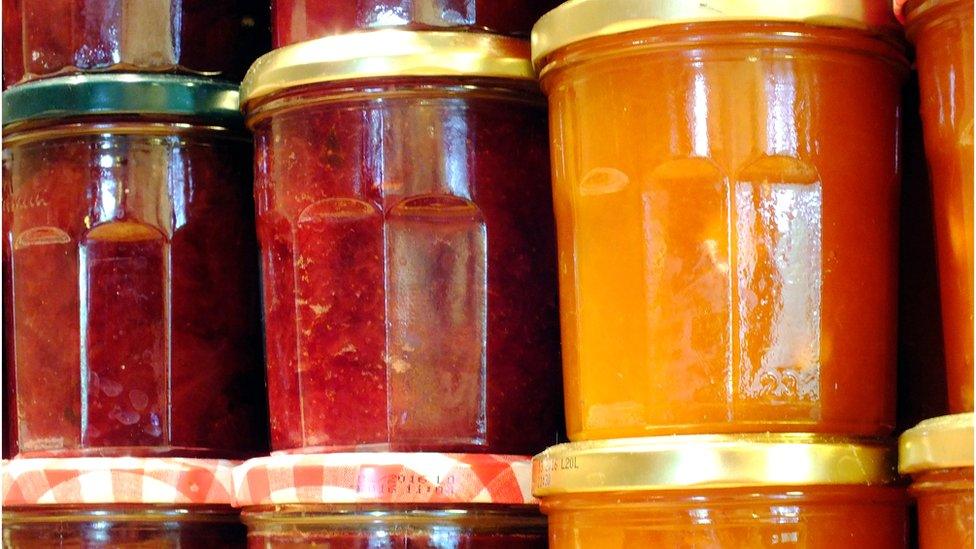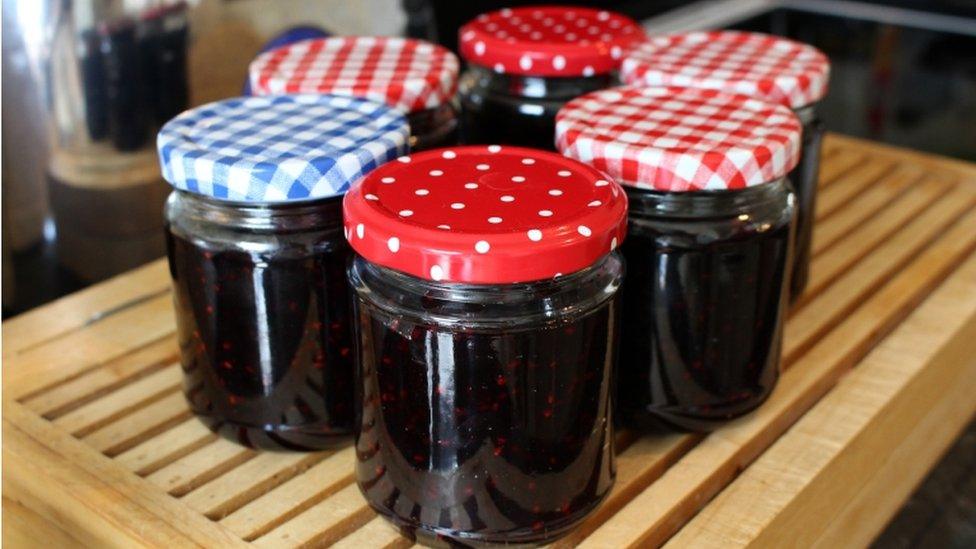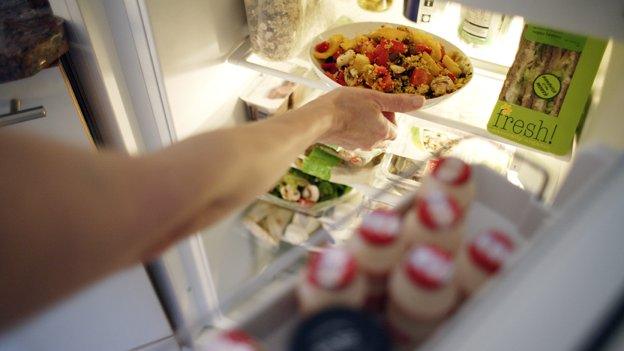Mouldy jam: Should you eat what's beneath?
- Published

Theresa May says she eats jam after removing mould from the surface, it's being reported
The toast pops. The butter's spread. Then you unscrew the lid and there it is - a circle of furry white-and-blue mould staring back at you from your strawberry jam jar.
Not very tempting but, according to reports in the Daily Mail, external, it's not enough to put off Theresa May.
The UK's prime minister has reportedly told senior ministers in a discussion about ways to reduce food waste that she scrapes off the mould and eats what's underneath.
But is that a good idea?
Well, the Food Standards Agency does not advise eating food that is obviously rotten or containing mould.
It says this is especially important for people in vulnerable groups, including children, the elderly, pregnant women and those who have a weakened immune system.
However, Michael Mosley feasted on jam and a range of other gone-off foods, under the guidance of mould expert Patrick Hickey, for a BBC documentary in 2014.
Jam with a thin layer of mould can be salvaged, he says.

If you scoop off all the mould and a few centimetres beneath to throw out difficult-to-see spores, the jam should be safe to eat.
And it's not just jam that is still edible despite a bit of mould, according to Michael Mosley's research.
Cheese

He says once you've cut off the mouldy part (being careful that the knife doesn't get contaminated by mould), cheddar and Parmesan are fine to eat.
As dry cheeses, they don't provide the moisture that mould needs to thrive and it doesn't normally penetrate below the surface.
Some cheeses, of course, are deliberately infected with fungi. Penicillium roqueforti gives blue cheeses such as stilton and Roquefort their flavour.
Soft cheeses are the really important ones to watch. The presence of mould suggests infection not just by unwelcome fungi but also harmful bacteria, such as listeria or salmonella. If that happens, throw it away.
Allow X content?
This article contains content provided by X. We ask for your permission before anything is loaded, as they may be using cookies and other technologies. You may want to read X’s cookie policy, external and privacy policy, external before accepting. To view this content choose ‘accept and continue’.
Bread

Delving in the bottom of the bag, you pull out a neglected piece of bread covered in small bits of white and blue mould. Cut those bits off, toast it and you'll be fine, says Patrick Hickey.
But it involves really looking at the type of mould.
"The time you really need to be worried about bread is when it has black bits on it."
If you see orange, yellow or black mould spots then throw the bread away, he advises.
The FSA cautions people against eating mouldy bread.
It says stale bread can be used safely in some recipes.
Allow X content?
This article contains content provided by X. We ask for your permission before anything is loaded, as they may be using cookies and other technologies. You may want to read X’s cookie policy, external and privacy policy, external before accepting. To view this content choose ‘accept and continue’.
Fruit and vegetables

Fruit normally lasts better than vegetables because the acid in fruit keeps harmful bacteria at bay but do be wary of apples.
They'll keep for ages but if there's a puncture in the skin, fungi can get in, says Patrick Hickey.
"There have been serious outbreaks in the past, incidents of people being poisoned by drinking bad apple juice, which contains a toxin called patulin."
How about a soup made with those long-forgotten, slightly slimy courgettes and carrots lurking at the back of the fridge?
Best not. That slime is caused by bacterial colonies growing on the surface. "You'd probably develop terrible stomach ache in a couple of hours, followed by stomach cramps and diarrhoea," says Patrick Hickey.
Nuts
Mouldy nuts are particularly dangerous because they harbour a fungus called Aspergillus flavus.
"This fungus produces one of the most deadly toxins known to humankind," says Patrick Hickey.
"The toxin accumulates in the liver and can cause liver cancer. If there's no mould on the shell and the internal part is sealed and protected, then we should be fine."
And the important bit: You can be flexible with "best before" or "sell by" dates but don't risk serious food poisoning by eating foods past their "use by" date, warns Patrick Hickey.
The FSA advice
Some species of mould can produce toxins that are known to have adverse effects in humans as well as in animals.
While it is possible that removing the mould and a significant amount of the surrounding product could remove any unseen toxins that are present, there is no guarantee that doing so would remove them all.
- Published13 February 2019

- Published22 October 2014

- Published23 July 2018
